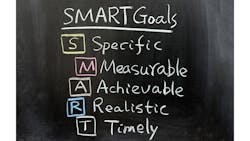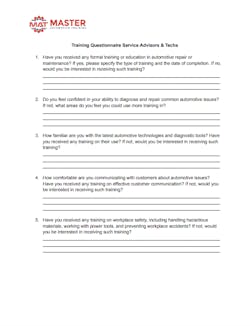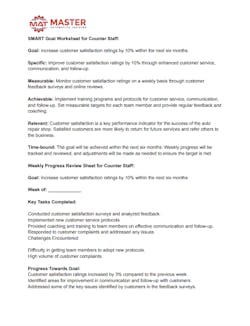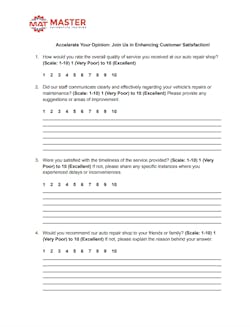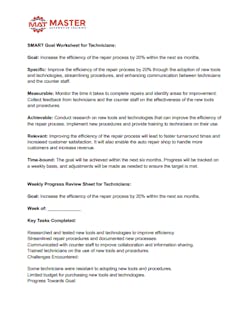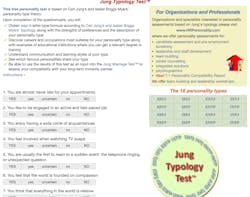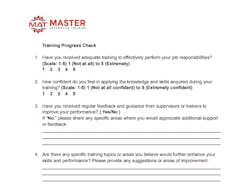Unlock your employees' potential: the power of a structured training plan
Content brought to you by Motor Age. To subscribe, click here.
What You Will Learn:
• Without documented goals, employees have nothing to strive for
• A structured training plan will streamline the path to success
• Structured training plan is not only for the technicians but for the customer-facing counter staff as well
A structured training plan is a crucial tool to maximize effectiveness, whether you're trying to upskill your technicians, offer professional advancement opportunities for your counter staff, or promote a culture of continuous learning and improvement.
With a structured training plan, you can define clear goals and objectives for your training activities, as well as make sure that your staff have the resources and support they need to be successful. Your staff will be aware of what has to be learned, how it will be learned, and when they may anticipate achieving their goals if you have a structured training strategy in place.
We'll discuss the value of a structured training program in this article, as well as the advantages it can provide to your technicians and counter staff. We'll also look at what makes a training program effective as well as how to design one that caters to the particular requirements of your staff. You'll have a better idea of how a structured training program can enable you to tap into your employees' full potential and drive company success by the end of this article.
Click here for downloadable PDFs of all the Master Automotive Training worksheets shown in this article.
Understanding the goals and objectives of the structured training plan
Understanding your desired goals and objectives is essential to creating an effective structured training strategy. Assessing the current expertise and knowledge of your technicians and counter staff is the first stage in this approach (Fig. 1). By doing so, you'll have a general idea of what they already know and what they still need to learn.
- In the realm of assessing an individual's knowledge and abilities, various methods are employed to gather information:
- Surveys and questionnaires can provide valuable insights into an individual's thoughts, feelings, and experiences on a particular subject.
- Performance evaluations offer a more objective assessment of how well someone performs specific tasks or responsibilities.
- Skills tests and exams are often used to evaluate a person's proficiency in a particular area, such as driving or writing.
- One-on-one interviews provide an opportunity for a more personal evaluation, allowing the evaluator to ask more in-depth questions and delve deeper into the individual's knowledge and experience.
Each of these methods has its strengths and weaknesses, and often a combination of several of these approaches is used to gain a more comprehensive understanding of an individual's abilities.
The assessment process should be set up to find out what your employees do well and where they could improve, as well as how they like to learn and what drives them to do so. This information will help you make a training plan for your employees that is tailored to their needs.
Setting clear and specific goals and objectives
Once you know what skills and knowledge your employees already have, the next step is to set clear goals and objectives for your training plan. These goals should be in line with your company's vision and mission, and they should show where your employees need to improve the most.
It’s essential to set goals that are specific, measurable, achievable, relevant, and time-bound, also known as SMART goals. For instance, one SMART goal could be to enhance the technical skills of technicians in a specific area (such as troubleshooting), by the end of the quarter. Another goal could be to equip counter staff with the necessary knowledge and skills to upsell products and services, by the end of the year.
Encouraging continuous learning and professional development is also a vital aspect of training, and one way to achieve this is by offering regular training opportunities and rewarding employees who meet or exceed their training goals. By setting SMART goals for a training plan, employers can ensure that their employees receive targeted and effective training, resulting in improved performance and productivity in the workplace.
As an example, the SMART goal for counter staff could be to increase customer satisfaction ratings by 10 percent within the next six months. To achieve this goal, the counter staff will implement training programs and protocols for customer service, communication, and follow-up. They will set measurable targets for each team member and provide regular feedback and coaching.
Customer satisfaction ratings will be monitored weekly through customer feedback surveys and online reviews. The goal is relevant as customer satisfaction is a key performance indicator for the success of the auto repair shop. Satisfied customers are more likely to return for future services and refer others to the business. The goal is time-bound and will be achieved within the next six months. Weekly progress will be tracked and reviewed, and adjustments will be made as needed to ensure the target is met.
Continuing, SMART goal(s) for technicians could be to increase the efficiency of the repair process by 20 percent within the next six months. To achieve this goal, the technicians will research new tools and technologies that can improve the efficiency of the repair process. They will implement new procedures and provide training to technicians on the tools’ use. The time it takes to complete repairs will be monitored, and areas for improvement will be identified. Feedback from technicians and the counter staff on the effectiveness of the new tools and procedures will be collected.
The goal is relevant, as improving the efficiency of the repair process will lead to faster turnaround times, increased customer satisfaction, and increased revenue. The goal is time-bound and will be achieved within the next six months. Weekly progress will be tracked, and adjustments will be made as needed to ensure the target is met.
The weekly progress review sheets for both counter staff and technicians will help to monitor progress and identify areas for improvement. The review sheet for counter staff includes tasks completed, challenges encountered, progress toward the goal, and an action plan for the next week. The review sheet for technicians includes tasks completed, challenges encountered, progress towards the goal, and an action plan for the next week. Regular review and adjustment of goals and tasks are essential to achieving success.
Having clear and specific goals for your employees will help you focus your efforts and resources. This way, you can make sure that your staff receives the best possible training. Additionally, having clear goals will help you determine how effective your training plan is and allow you to make changes if necessary to achieve the results you want.
Aligning training plan with company vision and mission
Your company's overall mission and vision should be reflected in your training plan. This means that your training should help your organization reach its strategic goals and show your employees how their work contributes to the success of the business.
For example, if your company's mission is to provide excellent customer service, then your training plan should focus on customer service skills like active listening, conflict resolution, and communication. If your company cares about the environment and wants to be sustainable, your training plan could include lessons on how to reduce waste and use products that are less harmful.
By aligning your training plan with your company's vision and mission, you will ensure that your training efforts are focused and effective, and that your employees are motivated and engaged in their learning experience.
Developing a structured training plan
Developing a structured training plan is crucial for the success of any auto repair shop. The first step in creating a training plan is to determine the training needs of technicians and counter staff. This can be achieved by conducting a skills assessment to identify areas where employees may require additional training or development. Once the training needs have been identified, the next step is to prioritize them based on the needs of the business and the employees.
The next step in developing a structured training plan is to identify the best training methods and techniques. This will depend on the nature of the training, the learning style of the employees, and the available resources. Some training methods that can be used include on-the-job training, classroom training, online training, and workshops. It's important to choose the method that will be most effective in achieving the desired learning outcomes. Additionally, the training plan should be designed to be interactive and engaging to maximize employee engagement and retention of knowledge.
Creating a timeline for the training plan is also an essential component. The timeline should be based on the prioritized training needs and the availability of resources. It should include milestones and deadlines to ensure that the training is delivered on time and within budget.
Finally, roles and responsibilities for training delivery and evaluation should be assigned to ensure that everyone involved in the training process understands their role and is accountable for the success of the training plan. This will help to ensure that the training plan is executed efficiently and effectively.
Implementing a structured training plan
Implementing a structured training plan is critical for the growth and development of an auto repair shop. To successfully implement a training plan, the shop owner must provide the necessary resources and support for training. This may include providing access to training materials, providing funding for training courses, and offering flexibility in scheduling to accommodate training sessions. Additionally, the shop owner should ensure that the employees have the necessary tools and equipment to apply their new skills and knowledge.
Monitoring progress and evaluating the effectiveness of the training is another crucial component of implementing a structured training plan. This can be achieved by setting specific goals and objectives and regularly checking progress against them. It's important to get feedback from employees on the effectiveness of the training and to make any necessary adjustments to improve the training plan.
By regularly monitoring progress and evaluating the effectiveness of the training, the shop owner can ensure that the employees are acquiring the necessary skills and knowledge to enhance their performance and the success of the shop.
Encouraging active participation and feedback from technicians and counter staff is also essential for the success of your training plan. Create a positive and supportive learning environment that encourages employees to ask questions and participate in training activities. Additionally, it's important to gather feedback from employees on their training experiences to identify areas where the training plan can be improved. By actively involving employees in the training process and encouraging their participation and feedback, the shop owner can ensure that the training plan is effective and meets the needs of the employees and the business.
Maintaining and refining your training plan
Just like car repairs are not a one-size-fits-all, refining your training plan is crucial for the continued success of my and your business. Regular review and evaluation of the training plan is essential to ensure that the training remains effective and relevant to the changing needs of the business and employees. By conducting regular assessments of the training plan, It can identify areas where improvements can be made, and make necessary adjustments to improve the effectiveness of the training.
Updating your training plan to reflect changes in technology, industry standards, and company goals is another essential component of maintaining and refining a structured training plan. The automotive industry is constantly evolving, and it's important to keep up with the latest technologies and industry standards. By updating the training plan regularly, I can ensure that my employees have the necessary skills and knowledge to stay ahead of the competition. Additionally, by aligning the training plan with the company's goals, I can ensure that the training is focused on achieving the desired outcomes for the business.
Continuously encouraging learning and development among technicians and counter staff is critical for maintaining a culture of learning and growth within the business. By offering ongoing training opportunities and promoting a culture of continuous learning, I can ensure that my employees remain engaged, motivated, and committed to their professional development. This can lead to improved employee retention, increased productivity, and better overall business performance.
Invest in employee development and learning for a skilled and motivated workforce
In the end, a training plan is a useful tool for both organizations and people. It helps make sure that employees have the skills and knowledge they need to do their jobs well and help the company reach its goals. A training plan that is well thought out can bring many benefits, such as increased productivity, better job performance, and higher morale among staff.
I think it's important for every business to have a structured training plan for their techs and counter staff. This investment in employee development and learning can lead to a more knowledgeable, skilled, and motivated workforce, which is important for the success of any business.
About the Author
Oscar Gomez
Contributing editor
Oscar Gomez is an ASE-certified Master Technician and the founder of Master Automotive Training in Rancho Cucamonga, California. Oscar’s goals include encouraging both new and experienced technicians to keep learning and growing, both as people and as professionals, and to improve the auto industry one technician at a time. He believes the most effective way to do so is to invest in education. Oscar aspires to one day attend a class conducted by one of his previous students.
